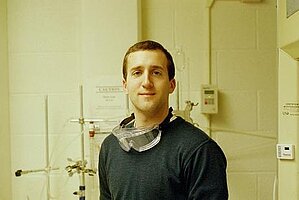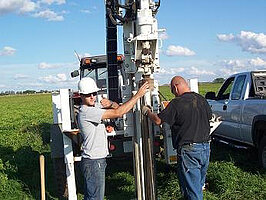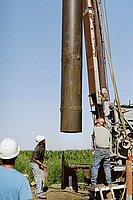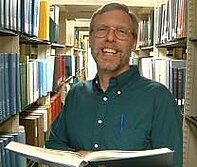Characterization of electron donor contents of aquifer sediments using a facies-based approach: Oakes Test Area (OTA), Dickey County ND.

Chase Christenson is a M.S. (Geology) student at the University of North Dakota in Grand Forks, ND. He graduated with a B.S. in Geology from UND in May of 2008. His research interests include denitrification and hydrogeochemistry.
chase.christenson@und.edu
Phone: 701-777-2821
Fellow: Chase Christenson
Advisor: Dr. Scott F. Korom, Associate Professor of Geology, University of North Dakota
Committee Members: Dr. Philip J. Gerla and Dr. Richard D. LeFever
Matching Support: University of North Dakota.
Degree Progress: M.S. in Geology expected in December 2009
Characterization of electron donor contents of aquifer sediments using a facies-based approach: Oakes Test Area (OTA), Dickey County ND.
Project Background:
Subsurface agricultural drainage, a continuously growing practice, has allowed the reclamation of unproductive land since the earliest of settlements. Despite it’s agricultural benefits, agricultural drainage bypasses the reduced zones where denitrification is likely to occur, contributing to higher nitrate yields as it is discharged directly to surface water. It is estimated that principal contributor of nitrogen inputs in the Gulf of Mexico and the North Atlantic Ocean are agricultural in origin.
Remediation of nitrate contamination may occur through denitrification. This naturally-occurring process reduces nitrate (NO3-) to harmless nitrogen gas. Denitrification through natural attenuation requires the following: the availability of electron donors, an oxygen-limited environment and the presence of nitrogen digesting bacteria. The availability of suitable electron donors within aquifer sediments has been shown to be the controlling factor in this reaction. The three most common electron donors are organic carbon, sulfide, and ferrous iron minerals.
Anaerobic groundwater draining into subsurface tile drains forms an ecological niche for iron-oxidizing bacteria. These bacteria obtain energy for growth from the reaction converting ferrous iron and oxygen into ferric iron and water. With respect to hydraulic efficiency, ferric iron forms highly insoluble ferric oxyhydroxides and some iron bacteria produce a sheath of slimy material, both f which tend to plug the tile drain system. However, with respect to nutrient transport, ferric oxyhydroxides may adsorb phosphorus (P) and iron bacteria denitrify nitrate concentrations in the tile effluent.
Project Objectives:
The Oakes Test Area (OTA) is a 64-hectare tile-drained agricultural site within the USBR Best Management Practices study area. Denitrification research performed at the site will include the following:
- Determine denitrification rates in aquifer sediments and around gravel drain envelopes at the OTA.
- Determine sediment properties that relate to NO3- reduction.
- Correlate NO3- reduction potential with sedimentary facies present at the OTA.
Progress:
- Collected Oakes aquifer core samples from 10 boreholes using a drill rig provided by the USBR.
- Installed two in situ mesocosms (ISMs) in the Oakes aquifer and initiated tracer tests in them. One of the ISMs appears to have a leak and the bromide is being diluted faster than expected. The other ISM has little dilution of the bromide tracer, but the amended nitrate is being lost more rapidly that at any other ISM on record, which includes 12 other ISM sites n Iowa, Minnesota, and North Dakota.
- Installed an in situ microcosm (ISm) in the gravel envelope next to a tile drain. Any denitrification measured here would be expected to be a result of iron bacteria, and not the gravel, because gravel is much less reactive than finer sediments.
- Ran a nutrient tracer test in the tile drain last June. Results show that NO3- behaved as conservatively as Br-, little to no TP was lost, and NH4+ was produced, possibly by cation exchange reactions with Na+ in the amended water with NH4+ on exchange sites associated with the biomass in the tile drain.
- Recovered sediment samples from tile drain gravel pack and biomass samples from tile drain.
- Conducted analyses on aquifer sediments to quantify electron donors (organic carbon, pyrite as S, ferrous iron) present in aquifer facies.
Significance of the Project:
Previous research has shown an inverse correlation between denitrification potential (electron donors) and grain size. The correlation between distinguishable facies of differing depositional environments would enable extrapolation of findings at the OTA to areas with similar geological makeup and history.
Modeling of natural systems requires simplification. This facies-based relationship will allow for simplification of contaminant transport modeling. Examination of potential nutrient uptake by tile-drain bacteria will provide information that aids the development of a procedure for subsurface drainage cleaning that optimizes hydraulic efficiency and reduces nutrient transport.



Scott F. Korom
Geology & Geological Engineering
UND


